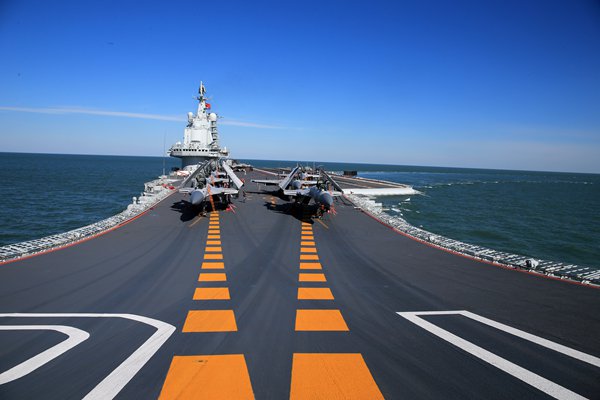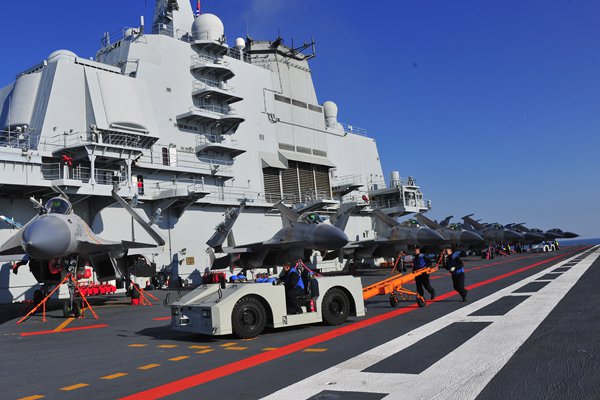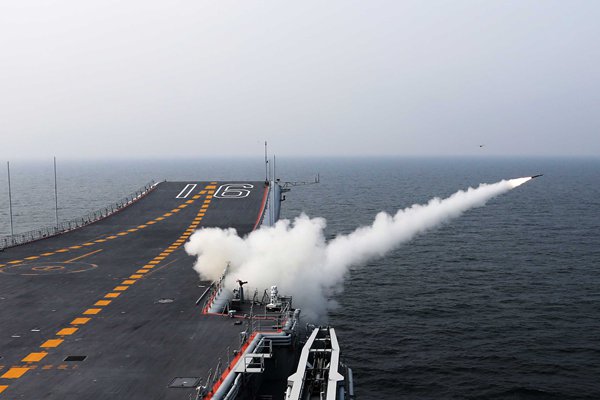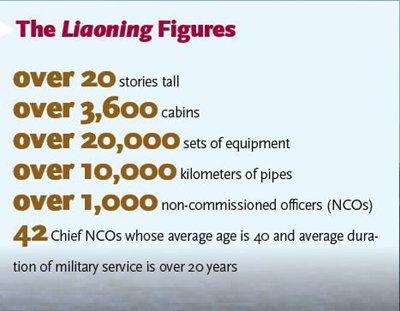
Posted on 11/15/2016 4:50:09 AM PST by sukhoi-30mki
After thousands of tests and training missions, China's first aircraft carrier, the Liaoning, is combat ready. A Global Times reporter recently visited the carrier, to find out how its crew members are selected and what roles they perform. After four years, the crew of the Liaoning went from knowing virtually nothing about the vessel to achieving an astonishing series of firsts.

Fighter planes sit on the deck of the Liaoning aircraft carrier. Photo: Zhang Kai

Fighter planes sit on the deck of the Liaoning aircraft carrier. Photo: Zhang Kai
For an outsider, seeing the Liaoning, with a displacement of more than 60,000 tons, appear from out of the darkness is a truly stunning sight.
Before boarding the Liaoning, passengers first have to pass security checks and surrender their cell phones and lighters. A guide then leads visitors onto the carrier.
Compared with minesweepers with a displacement of a few hundred tons, or destroyers and frigates with a displacement of thousands of tons, the deck of the Liaoning is broader than a football field.
Aside from domestic visitors, experts including American military officers have already taken a close look at the carrier.
According to media reports, three US senior officers and military commanders including the 24th Secretary of Defense Chuck Hagel, the 30th and the 31st Chiefs of Naval Operations Admiral Jonathan W. Greenert and Admiral John M. Richardson, set foot on the vessel during their visits to China.
Zhang Junshe, a senior researcher at the PLA Naval Military Studies Research Institute, believes that strengthening the Chinese and American military relationship will be good for minimizing conflicts and maintaining peace.
"We negotiate on what to show and what not to show during visits, usually the guest makes requests and respects the host's decision," Zhang told the Global Times. Both sides negotiate in advance about what military facilities or weapon equipment they will share.

The Liaoning launches a missile. Photo: Zhang Kai

The Liaoning up close
Aircraft carriers are a brand new business in China. In just a few years' time, the navy has developed a whole management system and is able to manage thousands of people's lives and training in an orderly manner, which wowed their American counterparts.
The orderly management can be seen in the details. Unlike destroyers and frigates, the Liaoning has lookouts at the entrance of the ladders to crew quarters. There is also a card reader, and crew members need to swipe their card when they leave and return to the Liaoning.
This is the crew members' "ID card" and it hangs on their chests. Their photo, name and department are all included on the card.
There is also a horizontal stripe made up of different colors and letters. The colors represent different departments and the letters represent the cabins they are allowed to enter. The department of aviation security is only entitled to visit two cabins for example.
On card of Li Dongyou, the political commissar of the Liaoning, there are eight colors and letters, which mean that he has an all-access-pass on the carrier. There is an inspection department supervising the enforcement of this rule.
In the mess hall, LED screens show rolling text of the working schedule and reminders for the day. In the place where the sailors return their plates, there are rules about leftovers, recyclables and nonrecyclables. Crew members have to fold their milk cartons flat before throwing them away.
There are more than 1,000 non-commissioned officers (NCOs) on the Liaoning. Among them, there are 42 senior NCOs, whose average age is 40 and they have all served in the military for more than 20 years.
"Senior non-commissioned officers are the hardcore. Their ability to use and maintain the equipment is irreplaceable and this is where our confidence lies," Li Dongyou told the Global Times.
There are more than 20,000 pieces of equipment on the Liaoning. The operation and maintenance manuals are all newly edited by the most experienced troops of the aircraft carrier force.
Zhang told the Global Times that the non-commissioned officer system is important in accelerating the military's construction and consolidating combat effectiveness.
Getting on the carrier
The aircraft carrier is more than 20 stories tall and has more than 3,600 cabins, and it takes practice to learn the ropes. A young seaman told the Global Times one of his first tasks when he came onboard was to figure out how to get around. "They tell us a cabin number and test our ability to get there in a certain amount of time."
The top officials onboard have already mastered this task. They learned this through experience and the tests of time. Most of the high officials on the carrier joined at the beginning, when the military first started selecting its crew.
The qualifications were that they needed to have displayed an excellent performance in their previous work units and have performed important military missions multiple times.
Li Lixiao, director of the testing section and an official with the aviation insurance department on board, told the Global Times that the test he took to get on the carrier included math, physics and other subjects, and the interview consisted of discussions about his professional knowledge and his willingness to serve on board.
On the desk of Li Linqing, director of the transportation section of the aviation insurance department, is a computer, on which one can clearly see the ship's working and arrangement schedule, as well as its news. There are also forums organized by different departments at which staff on the carrier discuss all sorts of topics, such as "Should people be allowed to use cell phones onboard?"
Li Dongyou told the Global Times that the cell phones and wireless Internet are allowed onboard the carrier, making it convenient for workers to get in contact with the outside world when the carrier docks.
"We need them to tolerate loneliness and hardships when working onboard the carrier, but we also hope to provide our staff with a good life," he said.
He explained that soldiers have seen a lot of improvement in their conditions of employment, especially their salaries. Right now, senior NCOs receive a monthly salary of over 10,000 yuan ($1,458), and ordinary NCOs can earn more than 4,000 yuan monthly, 10 times more than they did in 2000.
Besides better treatment, the workers can now enjoy entertainment onboard as well. There are soccer and basketball teams and soldiers are allowed to go out on weekends when the carrier docks. The soldiers also organize volunteer and charity events.

An officer gives directions to a fighter jet on the flight deck of the Liaoning. Photo: Zhang Kai
Operating smoothly
The Liaoning aircraft carrier used to be the Varyag, an old Soviet ship. When China first bought the carrier from Ukraine in 1998, the People's Liberation Army Navy had no data, no plans and no blueprints available, Li Lixiao said.
The aviation insurance department is in charge of making sure all the aircraft on the carrier are running smoothly and as such it's the most important department.
The department also needs to make sure the water, electricity, gas and air onboard are all under control.
Wang Chunhui, director of the gas section of the aviation insurance department said China has never had an aircraft carrier before and never had to deal with these kinds of issues. So they had to go about solving these issues on their own.
Years ago Wang and several other crew members started following the pipes inside the carrier and in this way, they found out where all the gas pipes are located, thousands of meters of them. They also measured how large the gas tanks are.
As there were no previous examples to follow, soldiers in different departments had to cooperate and experiment several times before they can make sure operational procedures go smoothly.
For example, the last link before an aircraft takes off from the carrier is loading its ammunition. It may look simple: the ammunition is taken out of storage, transferred to the deck through a lift and loaded into the aircraft, but it's not that simple in practice.
Li Dongbing, sergeant of the ammunition insurance squadron, told the Global Times that depending on the different types of weapons being loaded, the process may differ. Also, loading onboard a carrier at sea is different from loading on land; there may be lots of movement. In order to get it right, different departments had to drill this process hundreds of times.
It's obvious that the efforts of these soldiers have paid off. From September 25, 2012 to now, the Liaoning has finished a series of "firsts."
The carrier has satisfactorily performed all of its onboard procedures for the first time, organized the first research into the carrier's combat system, and organized the first navigation training in a formation with Liaoning at its center.
In mid-August, a new group of carrier-borne aircraft pilots launched J-15 jets onboard and passed evaluations for ski-jump takeoff and landing.
I am thoroughly impressed. Funny though, the west has been doing this since about 1930 or so. Are the Chinese that far behind?
Sigh, I wish I had a second hand piece of military or naval equipment....
Those red tie downs look like the ones at Harbor Freight!
Thanks for the post. One thing I noticed; there’s not much information on “fighting the ship.” Chinese no doubt have that held close. Chinese propaganda is like other efforts by closed societies. Lies.
Yes, but how bout damage control and fire suppression below decks?
Countries have been doing carrier aviation for almost a hundred years so there is no secret to the theory. All it takes is practice, and the Chines have been doing it for four years. The question is how are they on night air operations?
.
There are four stages to the learning process.
1) Unconscious incompetence. You have no idea how incompetent you are.
2) Conscious incompetence. You know enough to know you don’t know enough.
(the big jump)
3) Conscious competence. You are aware that you actually know what you are doing right.
4) Unconscious competence. You do it right without thinking about it while you are doing it.
I mention this because the Chinese are at stage 1, as far as aircraft carrier operations. The United States has been operating aircraft carriers for over 100 years, and has learned the hard way how to become competent in it.
And how will they do when the ship has been fighting for a couple of weeks, machinery is being pushed to the limit, and the crew is starting to get tired? Building the machine, and being able to perform the proper operation functions in a demonstration environment are one thing. Being able to keep everything going when you’ve been on general quarters for days and the equipment isn’t “admiral’s inspection” clean anymore, is a whole different ball of wax.
No. They are not far behind.
Most navies don’t operate carriers and developing carrier operations, even with Western (US!) help is very, very difficult.
This is an amazing and scary achievement on the PLAN. Think about it. The only other folks operating fleet carriers (not helicopter / VSTOL carriers) are the US, France, and India.
Hopefully, in the event of war, the Liaoning will make for a very happy submarine driver.
All they needed to learn they learned at the knee of Clinton who gave/sold them full access to all things naval including carrier ops.
Well, not exactly from scratch - they did have their stolen US Navy manuals.
Or were the instructions simply handed over by the clintons?
 ping
ping
And what is it with those tie downs? Perhaps there is some manufacturing process that makes them better, stronger, and lighter than than tie down chains...perhaps made of kevlar or something like that.
It is a nice, sunny day...hope they aren't expecting any with those.
I admit, I did chuckle at that. We usually learned it the other way, going FROM our "cabin" to our battle stations...:)
 talk about fair weather sailors,,,
talk about fair weather sailors,,, the first time waves break over their flight deck, i bet EVERY ONE of them will shat their pants
 LOL!!! yup, getting OUT is more important than getting in
LOL!!! yup, getting OUT is more important than getting in i mean, it's not like they have seacows waiting for them in their rack or something unlike other, well nevermind
Disclaimer: Opinions posted on Free Republic are those of the individual posters and do not necessarily represent the opinion of Free Republic or its management. All materials posted herein are protected by copyright law and the exemption for fair use of copyrighted works.